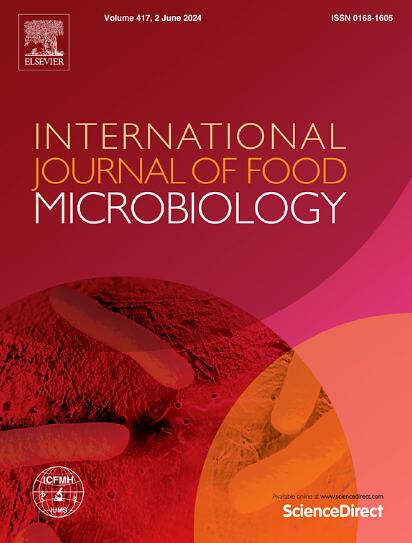Effect of heating rate on thermal inactivation kinetics of Escherichia coli O157:H7 in ground beef
IF 5
1区 农林科学
Q1 FOOD SCIENCE & TECHNOLOGY
International journal of food microbiology
Pub Date : 2025-03-10
DOI:10.1016/j.ijfoodmicro.2025.111152
引用次数: 0
Abstract
The objective of this study was to investigate the effect of heating rate on thermal inactivation kinetics of microorganisms in food, testing the survival of Escherichia coli O157:H7 in ground beef during isothermal and dynamic heating. A 4-strain cocktail of E. coli O157:H7 was inoculated to irradiation-sterilized ground beef (10 % fat) and then subjected to isothermal heating (55–63 °C) and dynamic heating (20–63 °C). One-step analysis was used to determine the kinetic parameters.
Different degrees of increased thermal resistance were observed in E. coli O157:H7 during dynamic heating. In comparison to isothermal heating, slight increase in the thermal resistance was found during fast heating (1.2–1.8 °C/min). However, slow heating (0.3–0.9 °C/min) led to significantly increased thermal resistance due to heat adaption at temperatures below 61.3 °C, but E. coli O157:H7 became more sensitive to heat above this temperature, suggesting that the increased resistance may diminish after reaching a critical temperature. To account for the increased heat resistance during dynamic heating, a unified kinetic model was developed and validated by applying one-step dynamic analysis, resulting in more accurate kinetic parameters to describe the survival curves of all heating rates.
This study demonstrated that the kinetic parameters derived from isothermal conditions may not be applicable to dynamic conditions. It is necessary to consider the effect of heating rate and to determine the thermal inactivation kinetic parameters under dynamic conditions. It also demonstrated the advantage of using one-step dynamic analysis for evaluating thermal processes. The results of this study may be particularly useful for designing slow-heating processes to ensure proper cooking of products.
加热速率对牛肉碎中大肠杆菌O157:H7热失活动力学的影响
本研究的目的是研究加热速率对食品中微生物热失活动力学的影响,测试在等温和动态加热过程中碎牛肉中大肠杆菌O157:H7的存活率。将4株大肠杆菌O157:H7鸡尾酒接种于辐照灭菌的碎牛肉(10%脂肪)上,然后进行等温加热(55-63℃)和动态加热(20-63℃)。采用一步分析法确定动力学参数。在动态加热过程中,大肠杆菌O157:H7的热阻有不同程度的增加。与等温加热相比,快速加热(1.2-1.8°C/min)时热阻略有增加。然而,在低于61.3℃的温度下,缓慢加热(0.3-0.9℃/min)导致热适应导致热阻显著增加,但大肠杆菌O157:H7对高于该温度的热更敏感,这表明在达到临界温度后,增加的热阻可能会减少。为了考虑动态加热过程中热阻的增加,建立了统一的动力学模型,并通过一步动力学分析进行了验证,从而获得了更准确的动力学参数来描述所有加热速率的生存曲线。该研究表明,在等温条件下得到的动力学参数可能不适用于动态条件。有必要考虑加热速率的影响,并确定动态条件下的热失活动力学参数。它还证明了使用一步动态分析来评估热过程的优势。这项研究的结果可能特别有用的设计慢热过程,以确保适当的烹饪产品。
本文章由计算机程序翻译,如有差异,请以英文原文为准。
求助全文
约1分钟内获得全文
求助全文
来源期刊
CiteScore
10.40
自引率
5.60%
发文量
322
审稿时长
65 days
期刊介绍:
The International Journal of Food Microbiology publishes papers dealing with all aspects of food microbiology. Articles must present information that is novel, has high impact and interest, and is of high scientific quality. They should provide scientific or technological advancement in the specific field of interest of the journal and enhance its strong international reputation. Preliminary or confirmatory results as well as contributions not strictly related to food microbiology will not be considered for publication.

 求助内容:
求助内容: 应助结果提醒方式:
应助结果提醒方式:


